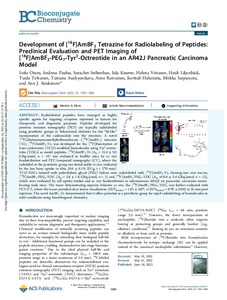Development of [18F]AmBF3 Tetrazine for Radiolabeling of Peptides: Preclinical Evaluation and PET Imaging of [18F]AmBF3-PEG7-Tyr3-Octreotide in an AR42J Pancreatic Carcinoma Model
Otaru Sofia; Paulus Andreas; Imlimthan Surachet; Kuurne Iida; Virtanen Helena; Liljenbäck Heidi; Tolvanen Tuula; Auchynnikava Tatsiana; Roivainen Anne; Helariutta Kerttuli; Sarparanta Mirkka; Airaksinen Anu J
Development of [18F]AmBF3 Tetrazine for Radiolabeling of Peptides: Preclinical Evaluation and PET Imaging of [18F]AmBF3-PEG7-Tyr3-Octreotide in an AR42J Pancreatic Carcinoma Model
Otaru Sofia
Paulus Andreas
Imlimthan Surachet
Kuurne Iida
Virtanen Helena
Liljenbäck Heidi
Tolvanen Tuula
Auchynnikava Tatsiana
Roivainen Anne
Helariutta Kerttuli
Sarparanta Mirkka
Airaksinen Anu J
AMER CHEMICAL SOC
Julkaisun pysyvä osoite on:
https://urn.fi/URN:NBN:fi-fe2022091258592
https://urn.fi/URN:NBN:fi-fe2022091258592
Tiivistelmä
Radiolabeled peptides have emerged as highly specific agents for targeting receptors expressed in tumors for therapeutic and diagnostic purposes. Peptides developed for positron emission tomography (PET) are typically radiolabeled using prosthetic groups or bifunctional chelators for fast "kit-like" incorporation of the radionuclide into the structure. A novel [F-18] alkylammoniomethyltrifluoroborate ([F-18]AmBF3) tetrazine (Tz), [F-18]AmBF3-Tz, was developed for the [F-18]fluorination of trans-cyclooctene (TCO)-modified biomolecules using Tyr(3)-octreotides (TOCs) as model peptides. [F-18]AmBF3-Tz (A(m) = 15.4 +/- 9.2 GBq/mu mol, n = 14) was evaluated in healthy mice by ex vivo biodistribution and PET/computed tomography (CT), where the radiolabel in the prosthetic group was found stable in vivo, indicated by the low bone uptake in tibia (0.4 +/- 0.1% ID/g, t = 270 min). TCO-TOCs tailored with polyethylene glycol (PEG) linkers were radiolabeled with [F-18]AmBF3-Tz, forming two new tracers, [F-18]AnBF(3)-PEG(4)-TOC (A(m) = 2.8 +/- 1.8 GBq/mu mol, n = 3) and [F-18]AnBF(3)-PEG(7)-TOC (A(m) of 6.0 +/- 3.4 GBq/mu mol, n = 13), which were evaluated by cell uptake studies and ex vivo biodistribution in subcutaneous AR42J rat pancreatic carcinoma tumor-bearing nude mice. The tracer demonstrating superior behavior ex vivo, the [F-18]ArnBF(3) -PEG(7)-TOC, was further evaluated with PET/CT, where the tracer provided dear tumor visualization (SUVbaseline = 1.01 +/- 0.07, vs SUVblocked = 0.76 +/- 0.04) at 25 min post injection. The novel AmBF3-Tz demonstrated that it offers potential as a prosthetic group for rapid radiolabeling of biomolecules in mild conditions using bioorthogonal chemistry.
Kokoelmat
- Rinnakkaistallenteet [27094]
